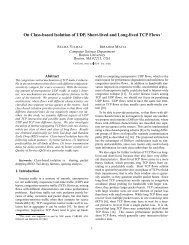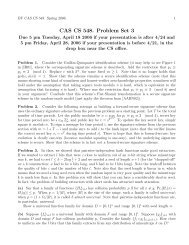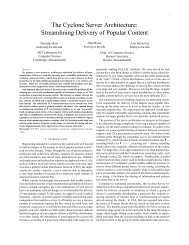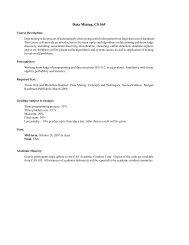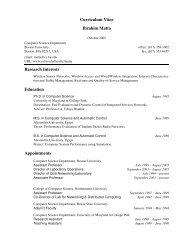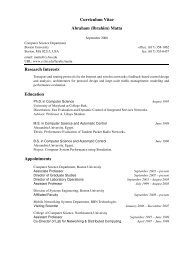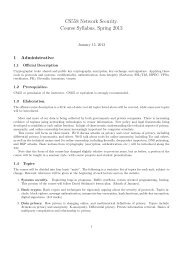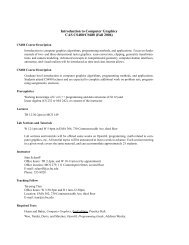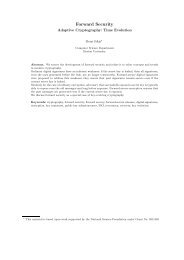uniform test of algorithmic randomness over a general ... - CiteSeerX
uniform test of algorithmic randomness over a general ... - CiteSeerX
uniform test of algorithmic randomness over a general ... - CiteSeerX
You also want an ePaper? Increase the reach of your titles
YUMPU automatically turns print PDFs into web optimized ePapers that Google loves.
8 PETER GÁCS<br />
When we fix canonical cells, we will <strong>general</strong>ly assume that the partition chosen is also<br />
“natural”. The bits x 1 , x 2 , . . . could contain information about the point x in decreasing<br />
order <strong>of</strong> importance from a macroscopic point <strong>of</strong> view. For example, for a container <strong>of</strong><br />
gas, the first few bits may describe, to a reasonable degree <strong>of</strong> precision, the amount <strong>of</strong><br />
gas in the left half <strong>of</strong> the container, the next few bits may describe the amounts in each<br />
quarter, the next few bits may describe the temperature in each half, the next few bits may<br />
describe again the amount <strong>of</strong> gas in each half, but now to more precision, etc. From now<br />
on, whenever Γ denotes a subset <strong>of</strong> X, it means a canonical cell. From now on, for elements<br />
<strong>of</strong> X 0 , we can talk about the n-th bit x n <strong>of</strong> the description <strong>of</strong> x: it is uniquely determined.<br />
The following observation will prove useful.<br />
Proposition 2.10. Suppose that the space X is compact and we have a separating sequence<br />
b i (x) as given above. Then the cells Γ s form a basis <strong>of</strong> the space X.<br />
Pro<strong>of</strong>. We need to prove that for every ball B(x, r), there is a cell x ∈ Γ s ⊂ B(x, r). Let C<br />
be the complement <strong>of</strong> B(x, r). For each point y <strong>of</strong> C, there is an i such that b i (x) · b i (y) < 0.<br />
In this case, let J 0 = { z : b i (z) < 0 }, J 1 = { z : b i (z) > 0 }. Let J(y) = J p such that y ∈ J p .<br />
Then C ⊂ ⋃ y J(y), and compactness implies that there is a finite sequence y 1, . . . , y k with<br />
C ⊂ ⋃ k<br />
j=1 J(y j). Clearly, there is a cell x ∈ Γ s ⊂ B(x, r) ⋃ k<br />
j=1 J(y j). □<br />
3. UNIFORM TESTS<br />
3.1. Universal <strong>uniform</strong> <strong>test</strong>. Let X = (X, d, D, α) be a computable metric space, and let<br />
M = (M(X), σ, ν) be the constructive topological space <strong>of</strong> probability measures <strong>over</strong> X. A<br />
<strong>randomness</strong> <strong>test</strong> is a function f : M × X → R with the following two properties.<br />
Condition 3.1.<br />
1. The function (µ, x) ↦→ f µ (x) is lower semicomputable. (Then for each µ, the integral<br />
µf µ = µ x f µ (x) exists.)<br />
2. µf µ 1.<br />
The value f µ (x) is intended to quantify the non<strong>randomness</strong> <strong>of</strong> the outcome x with respect<br />
to the probability measure µ. The larger the values the less random is x. Condition 3.1.2<br />
guarantees that the probability <strong>of</strong> those outcomes whose <strong>randomness</strong> is m is at most<br />
1/m. The definition <strong>of</strong> <strong>test</strong>s is in the spirit <strong>of</strong> Martin-Löf’s <strong>test</strong>s. The important difference is<br />
in the semicomputability condition: instead <strong>of</strong> restricting the measure µ to be computable,<br />
we require the <strong>test</strong> to be lower semicomputable also in its argument µ.<br />
Just as with Martin-Löf’s <strong>test</strong>s, we want to find a universal <strong>test</strong>; however, we seem to<br />
need a condition on the space X. Let us say that a sequence i ↦→ U i <strong>of</strong> sets has recognizable<br />
Boolean inclusions if the set<br />
{ (S, T ) : S, T are finite, ⋂ U i ⊂ ⋃<br />
U j }<br />
i∈S j∈T<br />
is recursively enumerable. We will say that a computable metric space has recognizable<br />
Boolean inclusions if this is true <strong>of</strong> the enumerated basis consisting <strong>of</strong> balls <strong>of</strong> the form<br />
B(x, r) where x ∈ D and r > 0 is a rational number.<br />
It is our conviction that the important metric spaces studied in probability theory have<br />
recognizable Boolean inclusions, and that proving this in each individual case should not<br />
be too difficult. For example, it does not seem difficult to prove this for the space C[0; 1] <strong>of</strong><br />
♦





